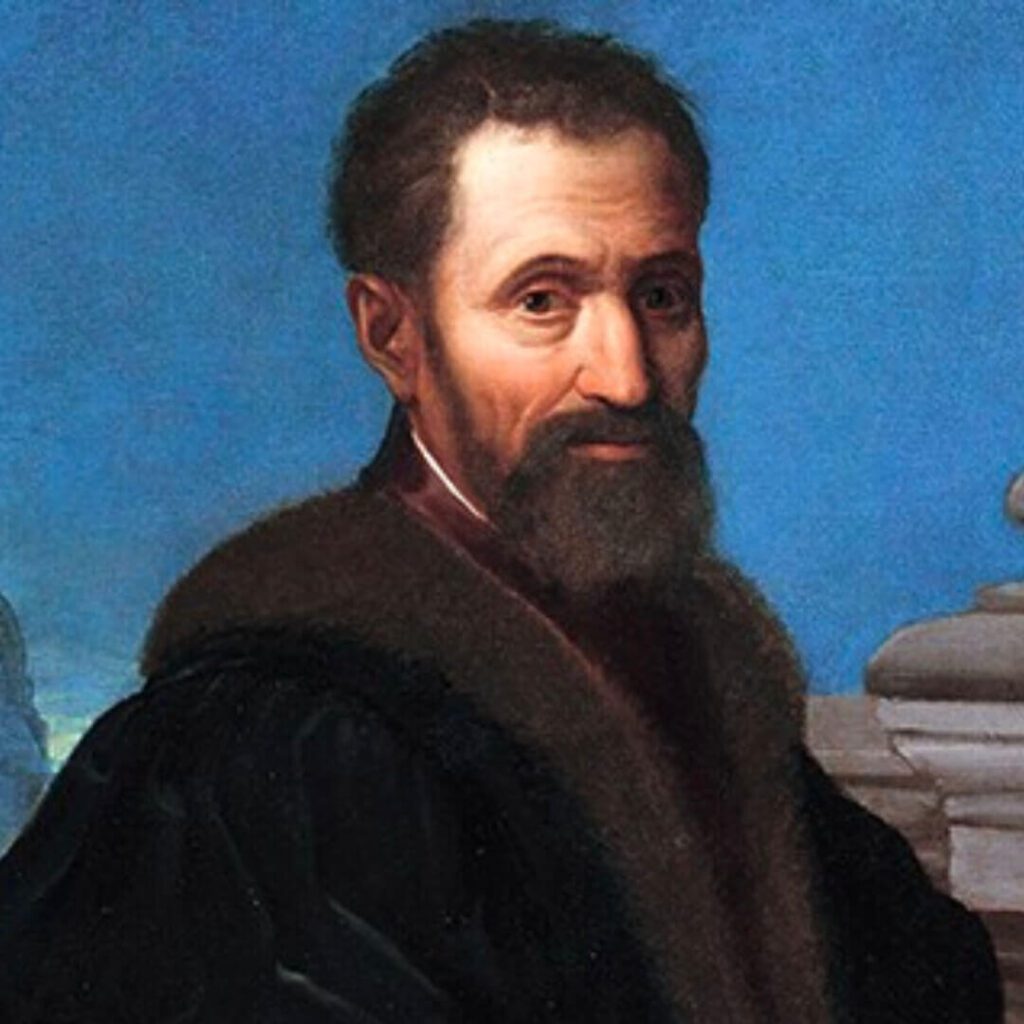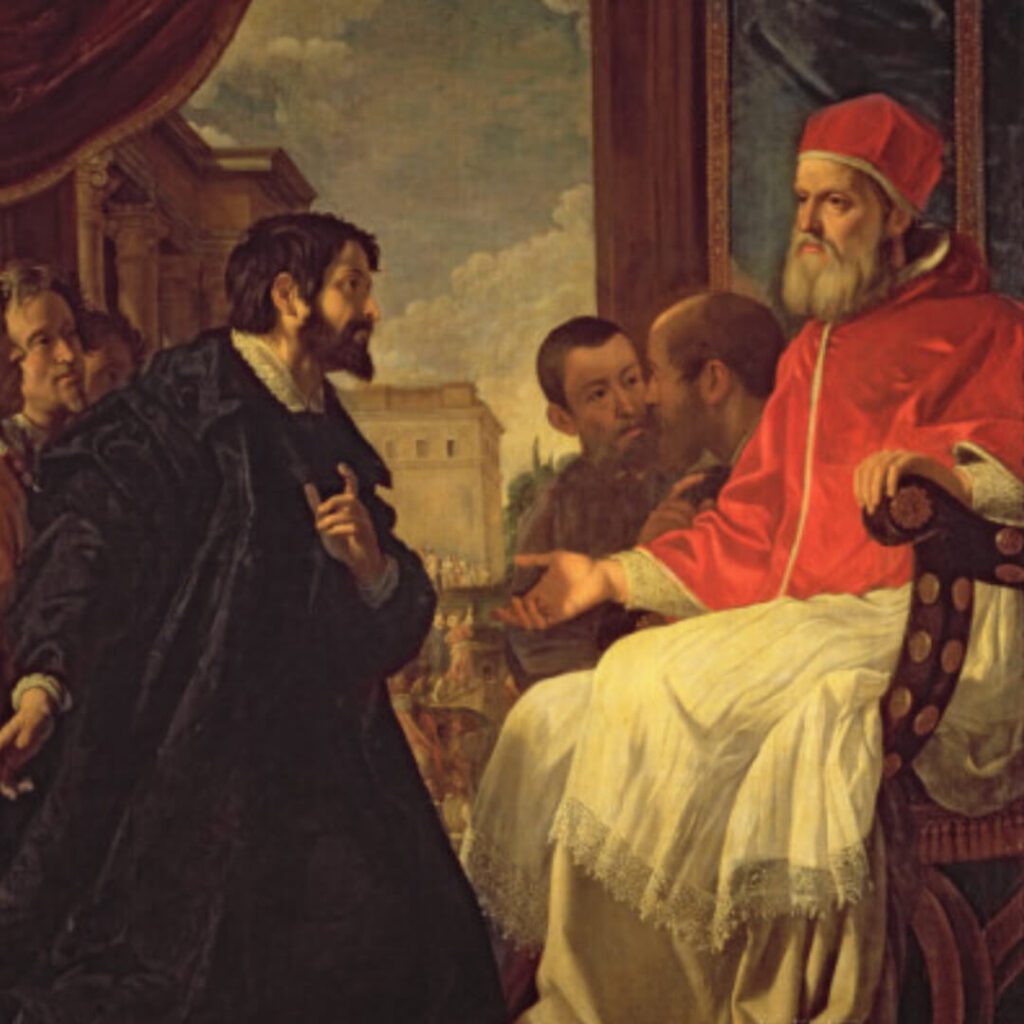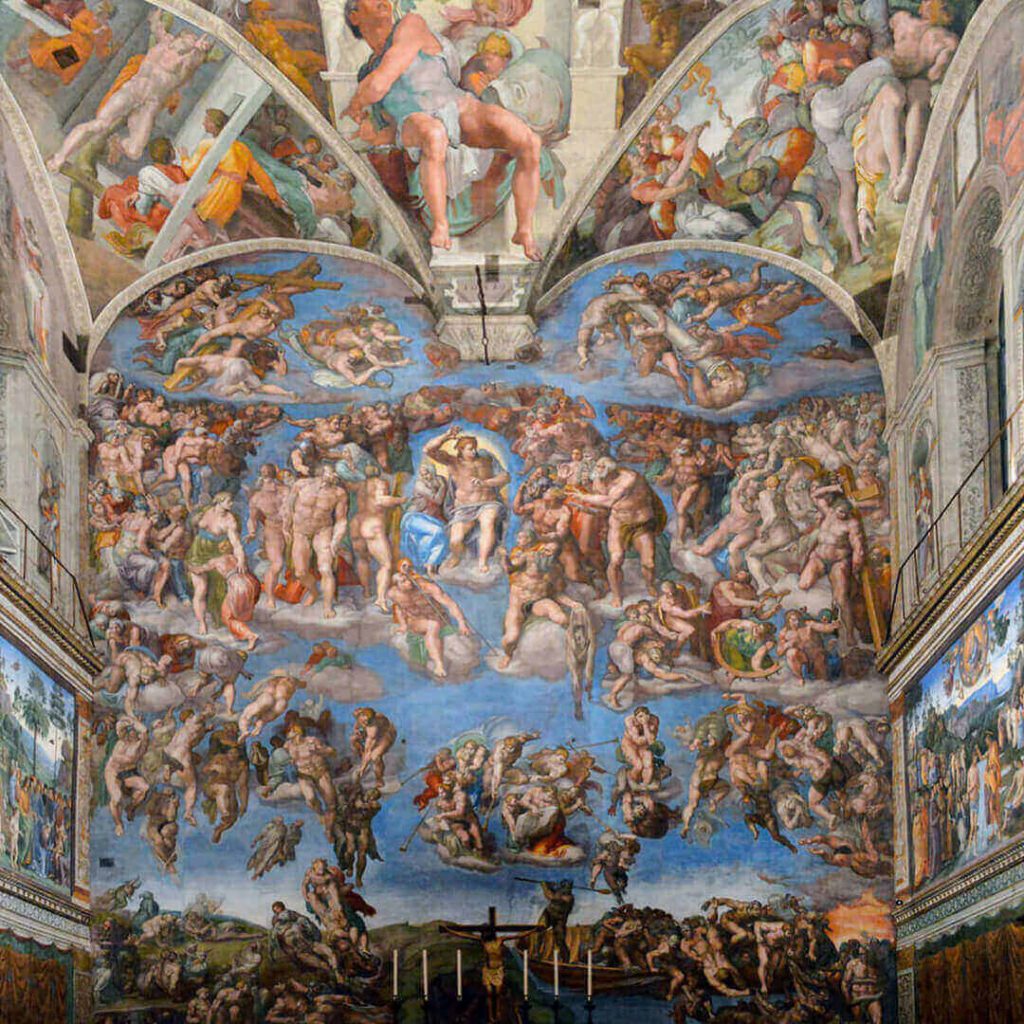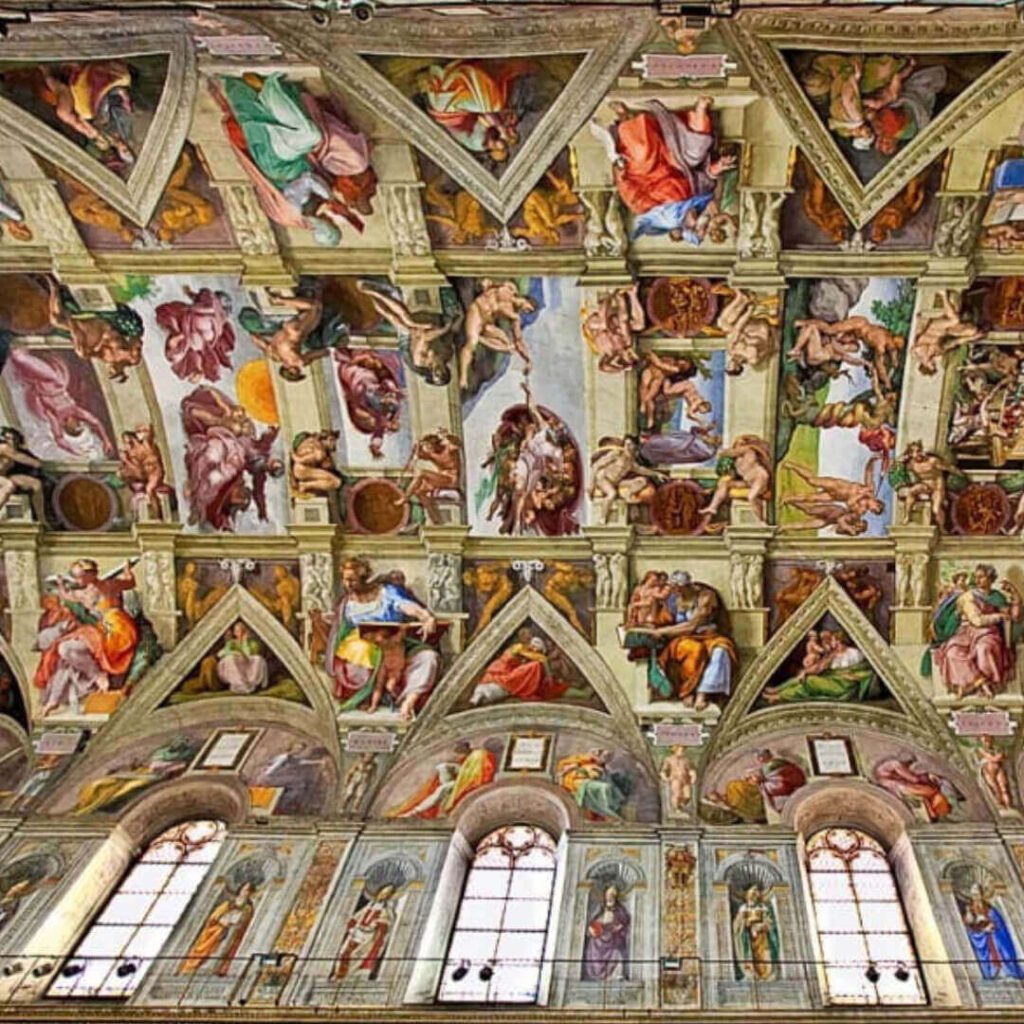One of my favorite art pieces from the Renaissance era is Michelangelo’s Sistine Chapel Ceiling. Michelangelo’s work on the Sistine Chapel ceiling cemented his place as one of the greatest artists ever.
His magnificent work on the Sistine Chapel Ceiling displays Michelangelo and his use of perspective, attention to detail, and mastery of the human form. Even today, more than 500 years after its completion, the Sistine Chapel ceiling remains a testament to the enduring power of art to move and inspire people worldwide.
Table of Contents
- Michelangelo And The Sistine Chapel Ceiling
- Who Was Michelangelo?
- Why Is Michelangelo Considered A Great Artist?
- 10 Reasons Why The Sistine Chapel Is An Important Work Of Art
- The Sistine Chapel Is A Renaissance Masterpiece
- The Sistine Chapel Is A Symbol Of Human Creativity
- The Sistine Chapels Has Scenes From The Bible
- The Sistine Chapel Showcases Michelangelo’s Great Skill
- The Sistine Chapel Ceiling Is A Tribute To The Human Form
- Michelangelo’s Sistine Chapel Is A Testament To The Power Of Art
- Sistine Chapel Reflects Renaissance Art Ideas
- The Sistine Chapel Is An Important Tourist Attraction
- Sistine Chapel Is An Italian Treasure
- Sistine Chapel Ceiling Is A World Heritage Site
- Frequently Asked Questions
- Related Questions
Read on as we will explore who Michelangelo was as an artist, why he is considered such a great artist, and why the Sistine Chapel is such an essential work of art.
Michelangelo And The Sistine Chapel Ceiling
The Sistine Chapel in Vatican City is one of the world’s most famous and revered works of art. It is impossible to mention the chapel without paying tribute to its creator, Michelangelo Buonarroti.
The chapel is named after Pope Sixtus IV, who commissioned its construction in the late 15th century. The chapel was designed to serve as a gathering place for important religious ceremonies, including the election of popes.
In the early 16th century, Pope Julius II commissioned Michelangelo to paint the chapel’s ceiling, which had previously been decorated with gold stars on a blue background. Michelangelo began work on the project in 1508, which took him four years to complete.
The finished ceiling is a masterpiece of art, comprising nine panels depicting stories from the book of Genesis and other figures and scenes.
The Sistine Chapel is one of the most significant and world-renowned works of art ever produced. Completed by Michelangelo in 1512, it is a masterpiece of Renaissance art and an enduring symbol of human creativity and genius.
Who Was Michelangelo?

Michelangelo di Lodovico Buonarroti Simoni, commonly known as Michelangelo, was born in 1475 in Caprese, Italy. He was one of the most influential artists of the Italian Renaissance, known for his sculptures, paintings, and architecture. Michelangelo began his career as a sculptor, and his early works, such as the “Pieta” and “David,” are considered masterpieces of Renaissance art.
Michelangelo was also a prolific painter, and his frescoes on the ceiling of the Sistine Chapel are some of his most famous works. Despite his success as an artist, Michelangelo was known for his difficult personality and often clashed with his patrons.
Michelangelo Was A Brilliant Artist – But Clashed Over The Sistine Chapel
Michelangelo was a brilliant artist, but he was also known for his difficult personality and tendency to clash with his patrons. He was fiercely independent and had a strong artistic vision, which sometimes put him at odds with the people who commissioned his work.

One example of Michelangelo’s difficult personality can be seen in his interactions with Pope Julius II, who commissioned him to paint the ceiling of the Sistine Chapel. Michelangelo and the Pope had a tumultuous relationship, with the artist often refusing the Pope’s requests and even storming off in anger at one point.
Despite their differences, however, the two men eventually developed mutual respect, and Michelangelo went on to create one of the greatest works of art in history.

Michelangelo’s difficult personality was not limited to his interactions with the Pope. He was also known to clash with other patrons and even with fellow artists. He was fiercely protective of his artistic vision and was not afraid to stand up for what he believed in, even if it meant going against the wishes of those who were paying him.
Despite his reputation for being difficult, Michelangelo’s talent was undeniable, and he left an indelible mark on the world of art. His work inspires and amazes people and his legacy as one of the greatest artists ever is secure.
Why Is Michelangelo Considered A Great Artist?
For several reasons, Michelangelo is considered one of the greatest artists ever. Here are some of the primary reasons why he is considered such a great Renaissance Artist:

Michelangelo Was A Master Of All Art Forms
Michelangelo was a master of many art forms, including sculpture, painting, and architecture. His works are characterized by their realism, emotional depth, and attention to detail.
Michelangelo Was A Pioneer Of The Renaissance Style
Michelangelo pioneered the Renaissance style, emphasizing a return to classical values and individualism. He is often credited with helping to usher in a new era of art and culture in Europe.
Michelangelo Influenced The Art World
Michelangelo’s influence on the art world is immeasurable. His works have inspired countless artists over the centuries, and his legacy continues today.
10 Reasons Why The Sistine Chapel Is An Important Work Of Art
The Sistine Chapel is an iconic work of art considered one of the most significant works ever produced in the Renaissance era. It is undoubtedly one of the most important works of art ever produced.

Here are ten reasons why the Sistine Chapel is such an essential work of art:
The Sistine Chapel Is A Renaissance Masterpiece
The Sistine Chapel ceiling is a stunning example of Renaissance art, showcasing Michelangelo’s incredible talent and innovative approach to painting.
The Sistine Chapel Is A Symbol Of Human Creativity
The Sistine Chapel ceiling is a testament to human genius and artistic mastery. It is a reminder of the incredible things humans can achieve.
The Sistine Chapels Has Scenes From The Bible
The Sistine Chapel ceiling depicts scenes from the Book of Genesis, visually representing the Bible and the Christian faith.
The Sistine Chapel Showcases Michelangelo’s Great Skill
The Sistine Chapel ceiling displays Michelangelo’s mastery of various techniques, such as chiaroscuro, foreshortening, and perspective.
The Sistine Chapel Ceiling Is A Tribute To The Human Form
The Sistine Chapel ceiling features numerous depictions of the human form, showcasing Michelangelo’s ability to capture the human body with incredible precision and emotion.
Michelangelo’s Sistine Chapel Is A Testament To The Power Of Art
The Sistine Chapel ceiling has the power to inspire awe and wonder in viewers, highlighting the incredible impact that art can have on people.
Sistine Chapel Reflects Renaissance Art Ideas
The Sistine Chapel ceiling is an essential representation of the Renaissance era, showcasing the time’s values, beliefs, and artistic styles.
The Sistine Chapel Is An Important Tourist Attraction
The Sistine Chapel is a popular tourist destination, drawing visitors worldwide to view its magnificent ceiling and other works of art.
Sistine Chapel Is An Italian Treasure
Sistine Chapel is one of Italy’s greatest treasures and a source of pride for the country and its people.
Sistine Chapel Ceiling Is A World Heritage Site
The Sistine Chapel is a UNESCO World Heritage Site recognized for its cultural and historical significance.
Michelangelo’s Sistine Chapel is an iconic work of art that continues to captivate and inspire people worldwide. Its significance lies in its artistic beauty and representation of human creativity, the Bible, and the Renaissance era. Michelangelo’s incredible skill and innovative approach to painting are showcased in the stunning frescoes on the ceiling, making the Sistine Chapel an enduring symbol of human genius and artistic mastery.
You can also read our blog about Michelangelo’s Sistine Chapel: A Testament To Human Genius to learn some of the fantastic paintings of Michelangelo in the Sistine Chapel by clicking here.
Anita Louise Art is dedicated to art education, great artists, and inspiring others to find and create their art. We love art that uplifts and inspires. #ArtToMakeYouSmile! #ArtToMakeYouHappy!
If you are interested to see any of my art, you can find out more by clicking here. If you are interested in what inspires me and my paintings, you can discover more by clicking here.
Subscribe to our Anita Louise Art YouTube Channel filled with great videos and information by clicking here.
Join us for our podcast “5 Minutes With Art.” Spend just 5 minutes a week with us to discover and learn about great art and artists. You can find out more about our podcast by clicking here.
Frequently Asked Questions
What is the Sistine Chapel, and why is it famous?
The Sistine Chapel is a renowned chapel located in Vatican City, known for its exquisite frescoes, including Michelangelo’s iconic ceiling. Its fame stems from the exceptional artistic achievements within, attracting millions of visitors yearly.
Who commissioned Michelangelo to paint the Sistine Chapel Ceiling?
Pope Julius II commissioned Michelangelo to paint the ceiling of the Sistine Chapel in 1508. The original task was to depict the twelve apostles, but Michelangelo proposed a more ambitious project, ultimately creating a masterpiece that transcends religious themes.
How long did it take Michelangelo to complete the Sistine Chapel Ceiling?
Michelangelo worked on the Sistine Chapel Ceiling for four years, from 1508 to 1512. Despite facing physical and artistic challenges, his dedication and skill resulted in one of the most celebrated works of art in history.
What is the central theme of the Sistine Chapel Ceiling frescoes?
The central theme of the frescoes is the story of Creation, starting with the creation of Adam and Eve in the center panels. The ceiling also features scenes from the Book of Genesis, showcasing Michelangelo’s deep understanding of biblical narratives.
How did Michelangelo paint the Sistine Chapel Ceiling?
Michelangelo employed the fresco technique, where pigments are applied directly onto wet plaster. This method required precision and speed, as the artist had to complete each section before the plaster dried. The intricate details and vibrant colors reveal Michelangelo’s mastery of this challenging medium.
What is the significance of the Creation of Adam panel?
The Creation of Adam is one of the most iconic panels on the Sistine Chapel Ceiling. It depicts the moment when God imparts life to Adam through touch. The powerful imagery of their outstretched hands, with fingertips almost touching, has become an enduring symbol of divine connection and human potential.
How did Michelangelo address the physical challenges of painting the ceiling?
Michelangelo faced physical strain and discomfort while working on the ceiling, often lying on his back for extended periods. To address these challenges, he ingeniously constructed a system of scaffolding that allowed him to paint while lying down, ensuring he could execute his artistic vision without compromising quality.
What other themes and scenes are depicted on the Sistine Chapel Ceiling?
In addition to the creation narrative, the ceiling features scenes from Genesis, including the Deluge, the Prophet Isaiah, and the ancestors of Christ. These diverse themes contribute to the overall richness and complexity of Michelangelo’s masterpiece.
How did the Sistine Chapel Ceiling influence Renaissance art and future generations of artists?
Michelangelo’s Sistine Chapel Ceiling had a profound impact on Renaissance art, setting new standards for technical skill and artistic expression. Its influence reverberated through subsequent generations, inspiring countless artists to push the boundaries of their craft and strive for greatness.
Can visitors still view Michelangelo’s Sistine Chapel Ceiling today?
Yes, the Sistine Chapel is open to the public, allowing visitors to experience the breathtaking beauty of Michelangelo’s masterpiece. However, due to the delicate nature of the artwork, photography is not permitted inside the chapel to preserve the integrity of the frescoes.
Related Questions
Did Michelangelo And Leonardo Know Each Other?
Michelangelo and Leonardo da Vinci knew each other but were considered bitter rivals. Leonardo da Vinci and Michelangelo knew each other, but they did like each other. They were both asked to do a commission on the Council Hall of the Palazzo Vecchio and were supposed to work side-by-side; the project was never completed.
By clicking here, you can learn more by reading Did Michelangelo And Leonardo Know Each Other?.
Michelangelo’s Method To Paint The Sistine Chapel Ceiling
He built a large scaffolding structure that could move around the chapel to paint the ceiling; the painting of the Sistine Chapel was an extremely strenuous work that was a huge personal cost both physically and mentally to Michelangelo.
By clicking here, you can learn more by reading Michelangelo’s Method To Paint The Sistine Chapel Ceiling.
Michelangelo’s Sistine Chapel And His Payment
Michelangelo was paid 3200 gold ducats for his work on the ceiling of the Sistine Chapel, which would have been a very lucrative commission. We know that he stopped work on the ceiling for a while due to his not being paid by the Vatican. Michelangelo liked to give the impression that he was a very poor artist, but records have shown that he died an extremely wealthy man.
By clicking here, you can learn more by reading Michelangelo’s Sistine Chapel And His Payment.


